Birdwatchers are being asked to help with some cutting-edge science, simply by reporting sightings of colour-dyed Dunlin and colour-ringed Curlew and Redshank.

The Severn: an empty estuary or a food-rich haven? (Corinna Blake)
The tides that create unique feeding opportunities for waders and other waterbirds on the Severn can potentially be harnessed to produce large amounts of clean energy. New impact assessment work aims to see how a development that would bring big benefits to the local economy might be carried out with as little negative environmental side-effects as possible.
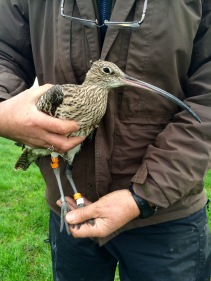
Birdwatchers are asked to look out for colour-ringed Curlew and Redshank (Kane Brides)
The Severn is a great place for birds, especially waders, attracted to the area by mud that has high densities of mud-loving invertebrates such as ragworms. It is designated as an SPA, because of its importance to wintering species such as Bewick’s Swan, Curlew, Dunlin, Pintail, Redshank and Shelduck, and the spring passage of Ringed Plovers. There’s more about the SPA on the JNCC’s website.
The British Trust for Ornithology and Wildfowl & Wetlands Trust scientists have been awarded a contract to undertake an Environmental Impact Assessment for the proposed Cardiff Tidal Lagoon by Tidal Lagoon Power, with BTO focusing on waders and WWT on ducks. It’s a unique opportunity not only to inform conservation planning but also to answer questions about the winter ecology of some key species. The team aims to:
- Validate and refine methods developed by Richard Stillman (Bournemouth University) that predict bird distributions from food availability. (It’s easier to map food distribution than to follow bird movements)
- Understand patterns of movement of species that use the proposed development area and other key sites, such as the Gwent Levels.
- Track birds in order to identify feeding and roosting areas that are used when birds are hard to observe – in poor weather, at night and at all stages of tide.
- Work out how mobile birds are, in order to propose ways in which lost feeding opportunities might be replicated as close by as possible.
Tagging
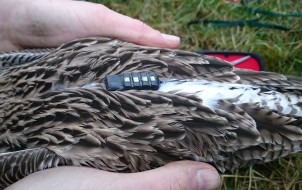
Tags like this should reveal how waders and ducks use the Severn estuary. Curlew by Lucy Wright.
Tagging is an important part of the project. Four-gramme Pathtrack tags are being glued to the backs of a sample of Curlew, Redshank, Shelduck and (hopefully) Shoveler. These should stay on for a couple of months, during which time movements will be logged every 90 minutes and downloaded using UHF receiving stations set up around the Severn. These four species have been chosen because, for each, more than 10% of the estuary’s population lies within the proposed footprint of the tidal lagoon.
Colour-rings
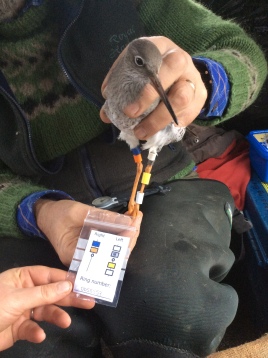
This colour-ringed Redshank may well breed in Iceland but which areas of mud-flat does it use in the winter? (Emily Scragg)
Tagged Redshank and Curlew are also being colour-ringed, alongside others that are not being tagged. By collecting reports of colour-ringed birds from birdwatchers, the BTO team will be able to monitor the efficacy of the tag down-load process and keep a track of movements when the tags stop transmitting. As an added bonus, the colour-rings may generate some new information about the breeding sites of waders that winter on the Severn.
Sightings of colour-ringed birds would be very much appreciated. Five rings have been used on both Redshank and Curlew. Please submit sightings (date time and ideally a six-figure grid reference) to Emily.scragg@bto.org who would also be interested in “ratio counts” of flocks of birds – simply the number of colour-rings and the size of the flock.
Colour-dyed Dunlin
The Severn Estuary holds an estimated 3.2% of the European wintering population of the alpina race of Dunlin, birds that breed from Siberia across to northern Scandinavia. Dunlin are too small to carry transmitters that can be used with base stations so the team has gone back to traditional picric dye in order to look at the mobility of flocks. Any sightings of colour-marked Dunlin will be appreciated by emily.scragg@bto.org. Where possible, please submit ratio counts broken up into yellow/orange on breast (adults), yellow/orange on the rump (juveniles) and unmarked birds, together with date, time and location (ideally with six-figure reference).
Colour-dyed Shelduck
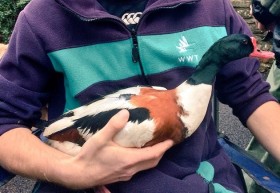
The neck of this tagged Shelduck will be dyed yellow before release (Kane Brides)
It’s not just waders. Over 3,000 Shelduck winter on the Severn, which is more than 1% of the European population. A sample has been caught by WWT. Ringed birds have a yellow/orange dye mark on the normally white plumage on the neck/upper breast (between the dark green head and the brown breast band). No Shoveler have been caught yet but the aim will be to put a similar dye-mark on these birds too. Sightings of dye-marked ducks should be reported to Ed.burrell@wwt.org.uk
Impact Assessment
The consortium of organisations that is working on this new tidal-power study is well placed to combine impact assessment with high quality wader science. By focusing on Curlew and Redshank, both red-listed species of conservation concerned, it is to be hoped that more will be learnt about the winter feeding ecology of these two species. The BTO team has already discovered that Redshank fly further at night than was previously thought and hope to get to understand some of the pressures facing Curlew, now classified as globally near-threatened (see separate WaderTales blog)
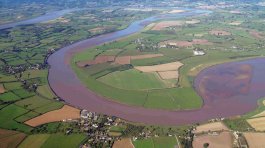
The Severn – Gareth Bradbury/WWT
This is not the first impact assessment work that has managed to incorporate research that increases the scientific understanding of wader behaviour and ecology. Two other examples are given below:
The Wash: Back in the 1970s, a plan to build huge reservoirs on the mud flats of the Wash, in which to store fresh water that might meet the growing demands of southeast England, led to a doubling of wader catching activity, intensive studies of their feeding ecology and complementary work on other taxa. Much was learned about the mobility of species within this huge estuary and the turn-over of birds within the annual cycle. A draft copy of the report is available on line at the NERC website
Cardiff Bay: In the period 1989 to 2003, long-term studies took place to try to understand the impacts of closing Cardiff Bay and hence reducing the amount of tidal feeding area for waders. Following the development, it was shown that Redshank that had been displaced from the Bay were in poorer condition and had lower survival rates in subsequent winters. There’s a summary on the JNCC website. The papers listed at the bottom of this JNCC web-page are essential reading for anyone trying to counter the ‘birds will simply go elsewhere’ arguments, which are sometimes put forward in favour of development work.
WaderTales blogs are written by Graham Appleton, to celebrate waders and wader research. Many of the articles are based on previously published papers, with the aim of making wader science available to a broader audience.

today (3/27/16 Brigantine Beach (Very North End) there were thousands and thousands of Dunlin birds!!!! It was amazing I have photos.
LikeLike
Pingback: Wales: a special place for waders | wadertales
Pingback: Tracking Mr Redshank | earthstar
Pingback: International Shorebird Rescue | wadertales